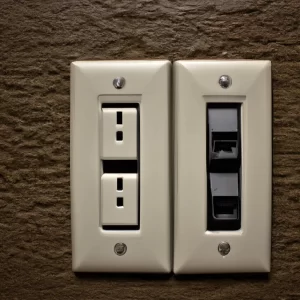The Benefits of Installing Warm Outlets and Switches in Your Home
 What are Warm Outlets and Switches and How Do They Work?
What are Warm Outlets and Switches and How Do They Work?
Warm outlets and switches are a type of electrical outlet or switch. Designed to reduce the risk of electric shock. Typically used in areas where there is a high risk of accidental contact with live wires, such as bathrooms, kitchens, and garages. Warm outlets and switches work by providing an extra layer of protection between the user and the live wires. This extra layer prevents any current from flowing through the user’s body if they were to come into contact with the live wires. In addition to preventing electric shocks, warm outlets and switches also help reduce energy consumption by reducing standby power loss.
How to Install Warm Outlets & Switches in Your Home
Installing warm outlets and switches in your home can be a great way to add convenience and safety to your living space. With the proper wiring and installation, you can ensure that your electrical outlets and switches are up to code and operating at peak performance. In this article, we will discuss the process of installing warm outlets and switches in your home. This includes the tools you need, the steps involved, and any potential safety concerns. With the right preparation and guidance, you can easily install them in no time!
The Advantages of Installing Warm Outlets & Switches in Your Home
Installing warm outlets and switches in your home can be a great way to save energy and money. These devices use less electricity than traditional outlets and switches, resulting in lower electricity bills. Additionally, they provide a more comfortable environment for your family. Designed to keep the temperature of the room more consistent.
They have many advantages over their traditional counterparts. Not only do they help you save energy and money. Overheating or short circuits cause the risk of electrical fires that they also reduce. Furthermore, warm outlets and switches are easier to install than their traditional counterparts, making them an ideal choice for anyone looking to upgrade their home’s electrical system.
What Are the Different Types of Warm Outlets & Switches Available?
When it comes to electrical safety, warm outlets and switches are a must. They provide a safer environment for your family and make sure that you don’t get shocked when using electrical appliances. There are many types available on the market today. In this article, we will discuss the different types of warm outlets and switches available so that you can make an informed decision when purchasing these products.
Different Types of Warm Outlets and Switches
Warm outlets and switches come in a variety of shapes, colours, and sizes. In order to choose the product that best suits your needs, you should know what type of outlet or switch you need. There are three types of outlets and switches: electric, gas, or water heaters. Below is a brief description of each type with specific examples:
Electric Outlets
These heaters contain electricity, which is converted into heat by resistive elements like coils located inside the heater housing. Electric heaters can be used for any kind of room in your home. Electric outlets are best for kitchens because they require a higher power rating than most other rooms.
Gas Outlets
Gas heaters contain combustion gases which is released to the heater housing before entering the heater coil, causing it to heat up rapidly. They are used as space heaters and typically found in living spaces like bedrooms, dining rooms, and living rooms. They are very efficient and safe in areas with high ceilings that allow for a proper draft from the flames.
Water Heaters
Water heaters use convection currents of heated water or steam to create heat within its casing before being transferred to the surrounding area.
How to Choose the Right Type of Warm Outlet or Switch for Your Home
Deciding for the right type of outlet or switch for your home is an important decision that can have a major impact on the safety and efficiency of your electrical system. Outlets and switches come in a variety of shapes, sizes, and styles, so it’s significant to understand the differences between them in order to make the best choice for your home. This article will provide an overview of what to consider when selecting outlets and switches for your home. This includes factors such as type, voltage rating, amperage rating, and installation requirements. With this information in hand, you’ll be able to decide for the best outlet or switch for your needs.
Types of Outlets & Switches
Outlets – wired for one or more electrical appliances, such as an electric stove or a coffee pot. You may also see these referred to as sockets or receptacles. Examples of outlets include those found on the standard power outlet strip in the kitchen, or those found in a bathroom outlet box.
Switches – used to turn devices on and off by manually moving a lever arm up and down. The most common application is using a light switch in the home’s main hallway near switches for lights, ceiling fans, and other devices.
Emergency Electrician Stoke-on-Trent
If you live in Stoke-on-Trent and require an emergency electrician, you’ve come to the right place. Emergency Electrician Stoke-on-Trent is here to help with any issues you may be having with your electrical systems. Whether it’s warm outlets or switches, flickering lights, or a complete power outage, we have the expertise and experience to get your home up and running again quickly and safely. We also offer call out services for those times when you require a plumber urgently. With our team of experienced plumbers on hand, we can provide reliable plumbing services at competitive prices. So if you’re looking for an emergency electrician in Stoke-on-Trent, contact us today!
